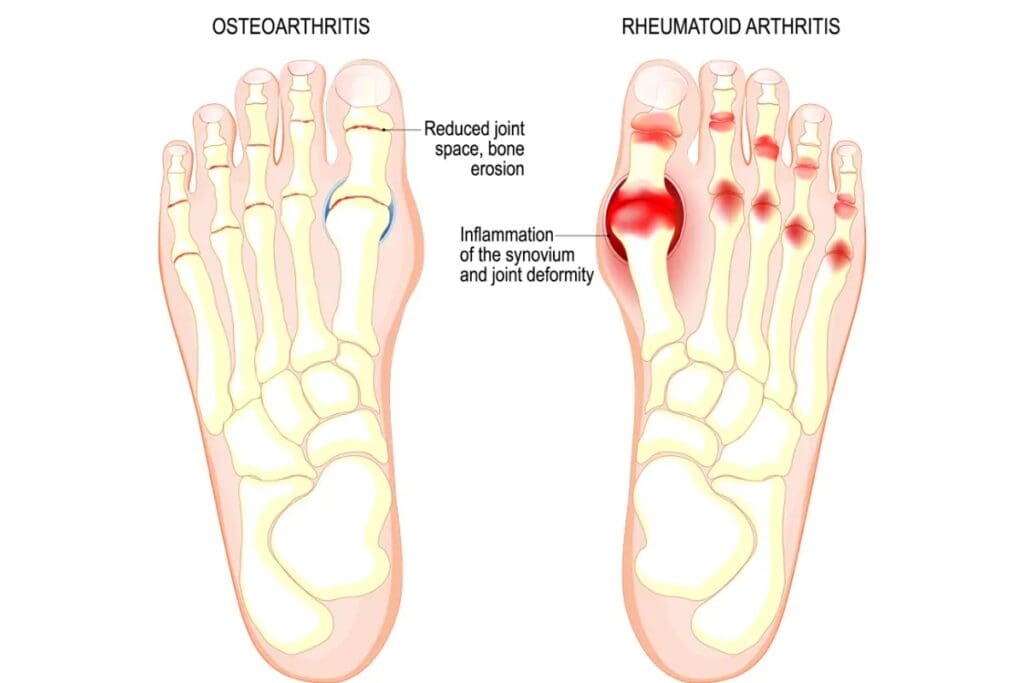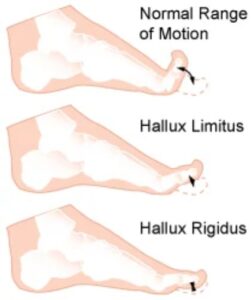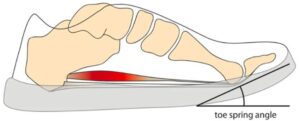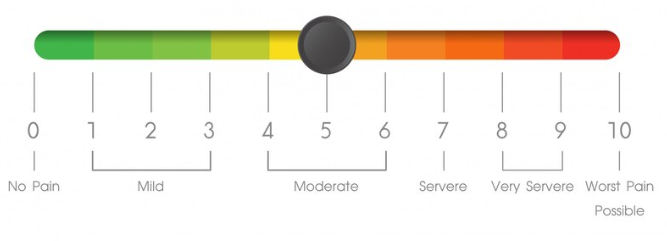Pain in your big toe – osteoarthritis
Pain in your big toe – osteoarthritis
What is osteoarthritis (hallux limitus/rigidus)?
Osteoarthritis is a condition which causes movement in joints to decrease over time. Eventually the joint becomes stiff and the protective tissue around it (cartilage) can become damaged, causing extra bone to form around the joint.
Osteoarthritis in your big toe joint restricts movement and causes pain when walking. Minor changes with a slight reduction of movement is known as hallux limitus. Significant reduction in movement or complete loss of motion at the big toe joint is known as hallux rigidus.
Changes to the big toe joint can affect the ability of your foot to remain stable when you are walking. This can result in increased pressure through your fore foot and you may develop a bony lump on the top of the big toe joint.

Signs and symptoms of osteoarthritis
 You may experience any or all of these symptoms:
You may experience any or all of these symptoms:
- pain, usually at the top of your big toe joint that worsens with weight bearing activity
- difficulty bending your big toe
- a bony lump/ soft tissue swelling on the top of your big toe joint that may hurt when it rubs against your shoe
- numbness or tingling if the bony lump is pressing on your nerves.
What causes osteoarthritis?
There is no specific cause of osteoarthritis in the toe joint but a number of things can increase your risk, most commonly, trauma or unusual foot anatomy – the length of your big toe can affect the function of the joint. Other contributary factors include:
- acute injury, such as stubbing your toe
- repetitive trauma with movements that will increase load through the big toe joint, such as squatting
- changes in the shape of the bones in your foot that can lead to osteoarthritis in the big toe joint
- inflammatory diseases such as rheumatoid arthritis
- unsupportive/ ill-fitting footwear
- family history.
What can I do to relieve the pain of osteoarthritis in my big toe?
Unfortunately there is no quick or easy fix and your symptoms will not improve overnight. Making simple changes to your lifestyle and choosing appropriate footwear can however improve the pain of osteoarthritis in your big toe.
Things to try:
- raising your foot on a stool and resting it when you can
- putting an ice pack (or bag of frozen peas) in a towel on the painful area for up to 20 minutes every two to three hours
- shoes with cushioned heels and good arch support
- insoles in your footwear
- regular stretching and foot exercises
- exercises which put no pressure on your feet, such as swimming
- losing weight if you’re overweight or obese.
Things to avoid:
- walking or standing for long periods
- wearing high heels or tight, pointy shoes
- wearing flip-flops or backless slippers
- walking barefoot on hard surfaces.
What shoes should I wear if I have osteoarthritis in my big toe?
It is important to be aware that your big toe joint may not bend enough to accommodate being in certain shoes. High heeled shoes in particular will place further stress on the big joint and the soft tissues around it.
 Wearing a shoe with a stiffer sole and/or a toe spring can be more comfortable. A toe spring is an upward curve at the toe of the shoe which lifts the front of the shoe off the ground and helps to reduce the stress in the joints and soft tissues in your feet when walking.
Wearing a shoe with a stiffer sole and/or a toe spring can be more comfortable. A toe spring is an upward curve at the toe of the shoe which lifts the front of the shoe off the ground and helps to reduce the stress in the joints and soft tissues in your feet when walking.
Find out more on our footwear advice page including how to check if shoes fit.
Ankle, foot and toe rehabilitation exercises
The following exercises will help to improve your pain over a period of time. Watch the video first, then try the exercise. There are six videos to try – go through to the next one below by clicking the arrow on the right of the video. All videos provided and shared with kind permission of, and thanks to, the Musculoskeletal Podiatry team at NHS Lanarkshire.
You need the use of a clear space of wall, a small towel, a small plastic bottle of water, a sports resistance band and a sports therapy ball. If you do not have a sports resistance band or sports therapy ball (also known as a soft spiked massage ball) these can be purchased relatively inexpensively online. If cost is an issue, focus on the exercises which do not use that equipment.
Important – pain levels: the NHS uses a pain scale where pain is measured from 0-10 (zero being no pain and 10 representing the worst pain you could imagine).

If you can identify the level of pain you are experiencing, you will find out if you are in the green, amber or red zone.
When you are completing your rehabilitation exercises it is often best to work within the green (and sometimes amber zones depending on what you deem is an acceptable level of pain) both during the exercises and within 48 hours of completing your exercises.
The best way to move down to the green zone is by pacing and spacing your activity. If you find yourself in the red zone you are likely pushing yourself too hard and the pain may flare up.
If you notice a large increase in your pain after doing the exercises, or you find that after six to twelve weeks there is no noticeable changes in your day to day symptoms, then please contact your GP or self-refer to our MSK podiatry team.